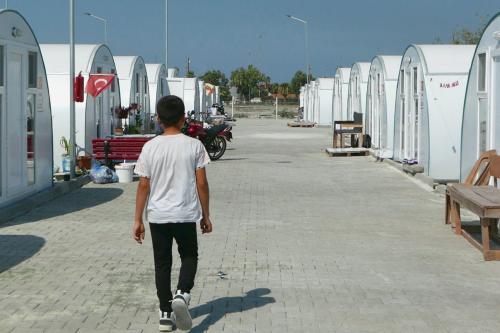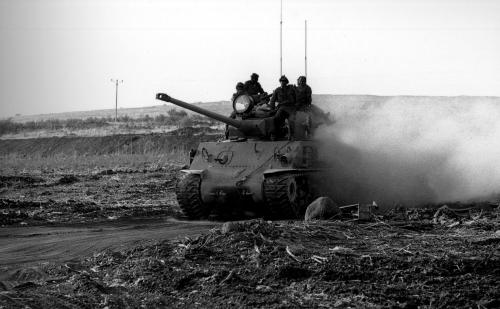Bashar al-Assad’s Syrian regime forces are suspected of using chemical weapons in an attack in a Damascus suburb last week.* In spring 2013, allegations surfaced that the regime had used chemical agents against civilians, and similar allegations arose in December. On August 20, 2012, President Obama said that any attempt by Syria to move or use its chemical weapons would be a “red line” that “would change my calculus.”
For now Obama’s concern seems to be to restore his credibility on that “red line” and establish a deterrence against further chemical weapon attacks. But that is not an adequate response to what we are witnessing in Syria now.
—
Michael O’Hanlon in
The Telegraph, 8/26/13
++
Last Friday, Shadi Hamid told NPR that Assad “believes he can act with impunity.”
… all indications point to elements of the regime being responsible. Now, why would they do that? Well, I think Assad feels that he can get away with pretty much anything. And so far he’s been proven largely correct. I mean he keeps on testing the limits of how far he can go. I mean he’s killed more than 100,000 people.
And up until now the international community’s response has been remarkably weak. So I think he’s been emboldened and believes he can act with impunity.
Brookings scholars have offered analysis and commentary on the issue over the last year.
In July 2012, Bruce Riedel looked at a possible Syrian end game and the regime’s arsenal of chemical weapons.
Would Bashar use chemical weapons against his own people? We can’t rule it out as the regime collapses.
In August 2012 congressional testimony, Martin Indyk spoke to the problem of Syria’s chemical weapons being transferred to others:
We should be consulting closely with the Israelis, given their knowledge of the Syrian army and their intense interest in ensuring that Syria’s chemical weapons are not transferred to Hezbollah or fall into the hands of jihadist elements.
In December 2012, Riedel said that intelligence is the key to stopping al Qaeda or Hezbollah from gaining control of a cache of Syrian chemical weapons.
How well al-Qaeda could maintain and use chemicals is unknown. Chemical weapons in amateur hands can be very dangerous both to the amateur and his enemy. We don’t want to take the chance.
Bessma Momani, in January 2013, wondered how many more Syrians must die before the international community intervenes:
Syria is being destroyed, one beautiful city after another, right before our eyes. Schools, hospitals, parks, private businesses, and entire public infrastructure are completely gone. There are fewer homes and places of work for Syrian refugees to return to, with each passing day.
Already, this instability is spilling into Lebanon. Already, this helplessness has taken root in extremism. It’s been too long that we’ve tried to justify our ‘Syria strategy’.
How many Syrians must die for the world to act?
Noah Shachtman explored the allegations that Syrian regime forces used chemical agents on rebel forces in Homs in a late December attack:
The issue of chemical weapons continues to loom over the conflict in Syria. The regime’s stockpiles are enormous, and they’ve been shown the willingness to prepare at least some of the agents for a possible attack. But for now, the U.S. government appears to have decided that, whatever happened in Homs, it didn’t cross the chemical “red line” that the President on down had pledged would trigger outside intervention into the civil war.
Shadi Hamid has noted that the “red line has managed to shift back and forth several times” and wondered:
Sure, the use of chemical weapons should be a red line for national security reasons, but why should strictly national security considerations be a red line, when the killing of tens of thousands isn’t? It is this latter point which sends precisely the wrong message to Arab audiences and the broader international community.
At a Brookings event on U.S.-Qatar relations in April 2013, His Excellency Hamad bin Jassim bin Jaber Al Thani, Qatari prime minister and minister of foreign affairs, said that Bashar al-Assad had recently used chemical weapons:
We put a lot of redlines. Chemicals? He used chemicals and there is evidence. But he used it in pockets, small pockets. He wanted to try your reaction. No reaction, he will escalate. He was using the bullets, then tanks, then airplanes, then rockets, then chemicals. So it’s testing; what is the level and where to stop.
Also in April, after the U.S. government said it believed that the Syrian regime used the nerve agent sarin, Ken Pollack recommended caution on the administration’s approach to Syria, noting the huge effort required. Still, he said:
At least for the moment, there would seem to be an easy out for the administration: the demonstration shot. The easiest move by the administration would be to pick out a valuable, discreet target of the regime’s and obliterate it—with cruise missiles and possibly manned aircraft as well. The strike would be a warning to the Syrians that worse would follow if the regime does not desist from further chemical warfare use and a demonstration that Washington will back up its red line.
Bruce Riedel explored the opportunities for U.S. intervention but warned of potential traps:
One trap is to avoid taking on a unilateral American military mission in Syria that would lead to mission creep and another quagmire that wouldn’t benefit Syria or America. Diplomacy, an arms embargo, isolation, and sanctions are a better approach. Behind the diplomacy, there is also an urgent need to begin building an international stabilization force, manned primarily by Muslim soldiers (mostly Turks at first, because they are the only capable troops immediately available), which can help end the civil war, help restore order, and serve as a basis for a new Syrian government elected by its people.
Hamid criticized the Obama administration’s “commitment to studied inaction” in the face of continued bloodshed in Syria:
… the focus on security implications — rather than focusing on the 70,000 already killed by good old-fashioned artillery and aircraft — suggests an outdated (and morally problematic) calculus for action. In saying that chemical weapons are a red line, the Obama administration is also saying that the killing of 70,000 Syrians is not a red line, which, when you think about it, is a remarkable thing to say.
Salman Shaikh said that the al-Assad regime has been emboldened by the international community’s weak response to his military campaign:
In the eyes of the regime, therefore, Obama’s “red line” prohibiting the use of chemical weapons — first drawn last August, in the midst of an election campaign — had to be tested.
It is time to get realistic about our options in Syria and to get beyond the impulse just to “do something.” We need a comprehensive approach that includes a viable exit strategy. The Bosnia model provides the best first draft for such a plan.
Dan Byman said that the administration’s ultimatum “seems like cheap talk” and “illustrates the risks of carelessly drawing red lines and issuing highly public threats that won’t be enforced.”
In the Syrian case, the red line on chemical weapons appears to have been issued without a decision as to how we might respond to a Syrian breach or even whether to escalate the situation. Politically this makes sense: it’s easier to agree that Syria should not use chemical weapons and issue a red line to advance deterrence than it is to decide what to do when Syria ignores the threat. But when deterrence fails, the United States looks weak and indecisive.
In June, a panel of Brookings scholars assessed the situation in Syria and the administration’s options, including arming Syrian opposition forces. In that exchange, Michael Doran said:
The provision of weapons alone is unlikely to drastically change the balance of power on the ground. What is needed, at a bare minimum, is a robust program of training and equipping the opposition, coupled with significant support in the areas of strategic planning, intelligence, and logistics. It is doubtful if at this stage the administration is considering such a broad package
Last week, Shachtman and Colum Lynch explored the complex intelligence issues around determining whether the Syrian regime actually employed chemical weapons.
Independent tests of environmental samples by both Russian and American spy services indicate that the deadly nerve agent sarin was used during a March 19 battle in Khan al-Assal, for example. Beyond that basic fact, there’s little agreement. The Russians blame the Syrian rebels for launching that unconventional strike on the Aleppo suburb, while the Americans say it was a case of chemical friendly fire.
* Update: Today, Secretary of State John Kerry called Syria’s use of chemical weapons last week “undeniable” and that it “should shock the conscience of the civilized world.”
++ Michael O’Hanlon writes that:
What we really need is an integrated strategy for ending the war that envisions a future political settlement among the belligerents. Such a strategy will require time. It will not work immediately and may ultimately involve the deployment of 10,000 or more U.S. troops to help implement any peace deal that may be reached in the future, once battlefield dynamics have evolved to the point where such a deal is feasible. Absent such a strategy, limited military action today might help re-establish U.S. credibility and deterrence, but will likely not meaningfully affect the trajectory of the conflict.



Commentary
Brookings Scholars on Syria’s Chemical Weapons Use and Obama Administration Response
August 26, 2013